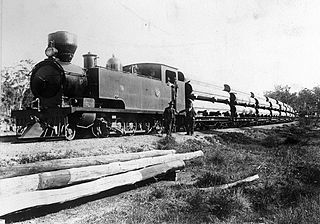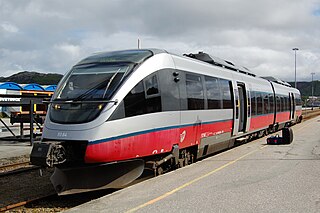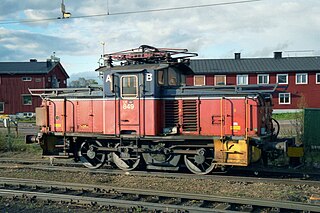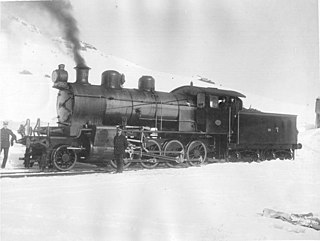
Under the Whyte notation, a 2-8-4 is a steam locomotive that has two unpowered leading wheels, followed by eight coupled and powered driving wheels, and four trailing wheels. This locomotive type is most often referred to as a Berkshire, though the Chesapeake and Ohio Railway used the name Kanawha for their 2-8-4s. In Europe, this wheel arrangement was mostly seen in mainline passenger express locomotives and, in certain countries, in tank locomotives.

The Dovre Line is a Norwegian railway line with three slightly different lines which all lead to the historic city of Trondheim.

The Norwegian Railway Museum is located at Hamar in Innlandet county, Norway. It is Norway's national railway museum.

NSB El 18 is a class of 22 electric locomotives built by Adtranz and Swiss Locomotive & Machine Works (SLM) for the Norwegian State Railways (NSB). The class is a modification of the Swiss Federal Railways Re 460 locomotive and built at Adtranz Strømmen in 1996 and 1997. The class remains the only mainline electric locomotive used by NSB, and is predominantly used on some intercity services and all night trains on the Bergen Line, Dovre Line and Sørland Line, as well as some regional trains.

The NSB El 17 is a class of twelve electric locomotives built by Thyssen-Henschel and Norsk Elektrisk & Brown Boveri (NEBB) for the Norwegian State Railways (NSB). The class was built in two batches, the first delivered in 1982 and numbered 2221–2226, and the second delivered in 1987 and numbered 2227–2232. The traction system of the El 17 was based on the DB Class 120 of Germany and were among the first in the world to feature three-phase asynchronous motors. The units were ordered to be used on the intercity Bergen, Dovre and Sørland Lines, but were plagued with technical faults. The unreliability and lack of sufficient power forced NSB to instead use them in the regional Vestfold and Gjøvik Lines. With the delivery of the El 18, the first series was retired or used as shunters. The second series has been used on the Flåm Line since 1998.

Class 93 is a tilting two-carriage diesel multiple unit used by SJ Norge for passenger trains on non-electrified stretches of the Norwegian railway network. Used on the Nordland Line, the Røros Line and the Rauma Line, they were purchased to replace the aging Di 3 locomotive-hauled trains. The Class 93 was produced by Bombardier, and is part of the Talent family. Fifteen units were delivered between 2000 and 2002.

NSB El 14 is a Norwegian electric locomotive operated by CargoNet for freight trains hauling. Built between 1968 and 1973 by Thune as a general purpose engine for the Norwegian State Railways (NSB), they were seen hauling passenger trains until the 1980s. Of the 31 units numbered 14 2164 to 14 2190 and 14 2197 to 14 2200, 11 remain in service.

The NSB El 11 was an electric locomotive which was operated for both passenger and freight trains by NSB. It was the third type of Norwegian electric locomotive with bogies, after the NSB El 7 and NSB El 9. They were manufactured by Norsk Elektrisk & Brown Boveri (NEBB) and Thune mekaniske verksted. The first 35 engines were built between 1951 and 1956 and numbered 11 2078 to 11 2112, a second series of 6 engines, the El 11b, was built between 1963 and 1964 and numbered 11 2145 to 11 2150. The b-series had minor modifications such as a windshield consisting of two large windows instead of four small ones. A further upgrade of the El 11 became the NSB El 13 locomotive.

NSB El 9 is a retired class of three electric locomotives built by Thune for the Norwegian State Railways (NSB), with electrical equipment from Norsk Elektrisk & Brown Boveri (NEBB) and Per Kure. The locomotives were delivered in 1947 after a three-year delay caused by wartime sabotage in response to the German occupation of Norway. They were used nearly exclusively on the Flåm Line and Hardanger Line, two steep branch lines. The units were used on the Flåm Line until 1983, when they were replaced by El 11. They were then used as shunters until being retired in 1988. Two of the locomotives have been preserved.

NSB Di 3 is a class of 35 diesel-electric locomotives built by NOHAB for the Norwegian State Railways (NSB). The class was built between 1954 and 1969, and delivered in two series, Di 3a and Di 3b. They are based on the Electro-Motive Division F7 and are equipped with EMD 567 engines. They have a distinct bulldog nose and were numbered 602–633 (a-series) and 641–643 (b-series). The locomotives had a prime mover that gives a power output of 1,305 kilowatts (1,750 hp). The a-series has a Co′Co′ wheel arrangement, while the b-series has (A1A)(A1A). The b-series has higher top speed, but lower tractive effort.

NSB Class 66 was a three-car electric train used by the Norwegian State Railways for express trains on the Østfold Line to Halden and Gothenburg, and the Sørlandet Line to Kristiansand and Stavanger. The four multiple units were built by Skabo Jernbanevognfabrikk, with motors from Norsk Elektrisk & Brown Boveri, and delivered in 1945–46. They were originally named Class 106, but this was changed in 1956. The trains received the numbering BFM 66.01–04, B 66.31–34 and BS 66.61–64.

The NSB class 30 was a 4-6-0 tender steam locomotive formerly used in Norway by Norwegian State Railways. The class 30 engines were an upsized version of the NSB Class 45 engines. Class 30 locomotives were originally intended for use on the Dovre Line, but they were employed throughout the Norwegian rail network. The first of these engines were produced in 1914, the last in 1939.

Hamar Station is a railway station of the Dovre Line and the Røros Line located in downtown Hamar, Norway. Located 126.26 kilometers (78.45 mi) from Oslo Central Station, it is served by long-distance and regional trains on the Dovre Line, as the terminus for regional trains on the Røros Line. All trains are operated by SJ Norge, except the regional trains between Lillehammer and Oslo, which are operated by Vy. A side platform and an island platform are in regular use. The station handled 1,062,300 passengers in 2008.

NSB Di 1 was a class of diesel-hydraulic locomotives built by Krupp for the Norwegian State Railways (NSB). The locomotive had two MAN diesel engines, giving a combined power output of 1,472 kilowatts (1,974 hp) and allowing the 82.7 tonnes vehicle to reach a maximum speed of 100 km/h (62 mph). It had a 1'BB'1 wheel arrangement and a driver's cab at only one end.

NSB Di 2 was a class of 54 diesel-hydraulic locomotives operated by the Norwegian State Railways (NSB). Six units were built by Maschinenbau Kiel (MaK) of Kiel, Germany, and the remaining by Thune in Oslo. The locomotives were used for shunting and for local and light freight trains throughout NSBs network. Based on MaK's 575C design, the locomotives were 10.0 meters long and had a C wheel arrangement.
Thunes Mekaniske Værksted A/S, Thune for short, was a Norwegian manufacturing company that among other things built locomotives. The production facilities were last located at Skøyen.
NSB Class 88 was a class of six three-car diesel-hydraulic multiple units built by Strømmens Værksted for the Norwegian State Railways. Derived from the German DRG Class SVT 877, the trains were the diesel counterpart of Class 66. The trains were built as express trains on the Bergen Line and the Dovre Line, serving the routes from Oslo to Bergen and Trondheim. The first four units were delivered in 1945 and 1946, but mechanical failures caused them to highly unreliable until 1950. Two more units were delivered in 1958. Retirement started in 1963 and from 1965 the trains were moved to the Røros Line. They left regular service from 1970 and were chopped three years later.

U is a class of 152 electric shunter locomotives operated by the Swedish State Railways and Trafikaktiebolaget Grängesberg–Oxelösunds Järnvägar (TGOJ) of Sweden, and the Norwegian State Railways (NSB), LKAB and Norsk Jernverk of Norway. They were built by ASEA, Nyqvist och Holm, Motala, ASJ Falun and Thune between 1926 and 1956. NSB gave the class the designation El 10.

The NSB Type 22 steam locomotives were built between 1906 and 1908 by Thunes mekaniske verksted and Hamar Jernstøberi for the Norges Statsbaner (NSB), the state railway company in Norway.

The NSB Type 32 was built between 1915 and 1921 by Baldwin Locomotive Works, the Vagn- & Maskinfabriksaktiebolaget Falun and Hamar Jernstøberi for the Norges Statsbaner (NSB), the state railway company in Norway. The Norsk Hoved-Jernbane (NHJ) also received two locomotives.


















